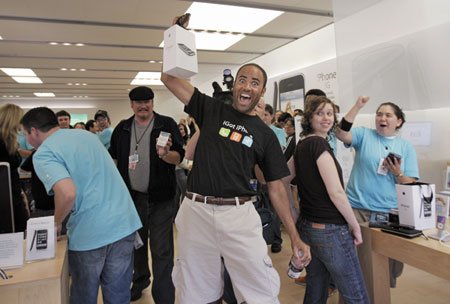A faster, cheaper, smarter iPhone went on sale Friday morning,
promising to bring the latest technology to more of the masses
while changing the way people find information, their friends and
fun.
Stanley A. Miller – Milwaukee Journal Sentinel
MILWAUKEE
A faster, cheaper, smarter iPhone went on sale Friday morning, promising to bring the latest technology to more of the masses while changing the way people find information, their friends and fun.
Satellite navigation is one of the biggest additions to the music-playing, picture-taking, Web-surfing, e-mail-reading smart phone from Apple, which has sold about 6 million of the original device so far.
So now the phone can know exactly where it is, and potentially how it can help its owner, whether it’s knowing which nearby stores are having sales, what restaurants are open or what bars are having happy hour. The new iPhones cost $199 to $699, depending on terms set by AT&T Wireless, the only carrier selling the device in the United States.
“Everything about the iPhone is so easy and so cool,” said A-Sun Truth, CEO of Universal Interactive Networks, a mobile media and networking company in Milwaukee.
Apple says the new iPhone, called the iPhone 3G, downloads Web pages, music from the iTunes store and other data twice as fast as the original using third-generation mobile phone networks.
That speed will provide a wider wireless pipe for all kinds of new software and services on the iPhone 3G, Truth said, “that will enhance the way human beings communicate.”
Still, Damon Brown, author of “The Pocket Idiot’s Guide to the iPhone,” said the iPhone 3G won’t be “the everyman’s phone.”
Despite a lower price compared with the original iPhone, which cost $499 and $599 depending on the model when it first launched about a year ago, Brown said the latest generation is still a luxury item.
“I think it will be similar to the iPod” in its level of popularity, Brown said.
“There are soccer moms and other people who aren’t early adopters who are really going to want an iPhone,” Brown said. “A lot more people will have it. I think it will be a little less elitist … a little more mainstream.”
And although iPhone buyers should expect lines forming outside AT&T and Apple stores sometime Thursday, it’s unlikely it will sell out, Brown said.
Faster speed and the iPhone’s new Global Positioning System navigation technology will let iPhone users find locations and their friends easier, Truth said, adding a new dimension to mobile social networking.
“An iPhone user can come to our mobile Web site … and find any party going on near them,” Truth said, mentioning a project in progress called MOCO.mobi. “We are working with DJs, bands and other entertainment venues” listing their events so the iPhone shows nearby activities based on where you are standing.
“Our users can use their iPhone to find the hottest events in their area and invite their friends, whether it is a party, art show or restaurant opening,” he said.
Truth said the new iPhone will shake up the cell phone world by letting people make phone calls using voice over Internet protocol services instead of using their wireless minutes.
VoIP software transmits voice data over the Internet similar to phone calls, and it can be done using the new iPhone’s Wi-Fi or third-generation data connection, he said.
“The carrier misses out on lots (of) voice minutes,” Truth said. “The carriers are going to have to adapt to the environment just like everyone else.”
Meanwhile, software designers such as Mark Roller, founder of Ascedia, are brainstorming new ideas for iPhone, whether those are downloadable programs stored on the device or Web-based applications accessed through the phone’s Safari browser.
“It is a pretty powerful device to carry around in your pocket,” said Roller, whose firm has offices in Milwaukee, Madison and Chicago.
Roller, an owner of two iPhones, noted that a new iPhone App Store online will let people buy and download programs for their phones, adding all kinds of potential convenience.
Being able to tap into the new iPhone’s GPS technology will open up new possibilities, he said.
“That to me is a revolutionary feature,” Roller said, mentioning GPS-powered maps showing nearby restaurants, coffee shops and other establishments with the ability to make purchases or offer coupons through the phone. “The things on our radar are travel-based. Those are some of the things I am excited about because it happens transparently.”
Truth said a wireless peer-to-peer payment program his company built for a bank in South Korea could turn the iPhone into an electronic wallet that could let iPhone owners buy items wirelessly.
That kind of technology is already prevalent in Asia, and a device like the iPhone with its intuitive interface could help make it popular here, Truth said.
“The iPhone is the device that makes it easy, and that is very important to consumers,” he said, noting that iPhone owners are already comfortable buying music and videos wirelessly through the iTunes store. “It’s a red carpet on a yellow brick road.”
Roller compared the potential utility of the iPhone 3G loaded with advanced software to the tricorder on the science-fiction classic “Star Trek,” an almost magical minicomputer that would conjure up the answers to almost anything.
“I think that is still what people are looking for in a device,” he said.
For an in-depth video walkthrough of the iPhone 3G’s features, see www.apple.com/iphone/
guidedtour .













